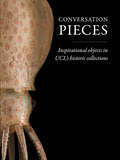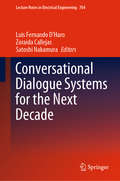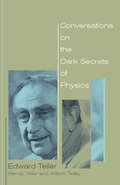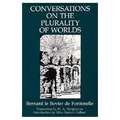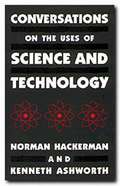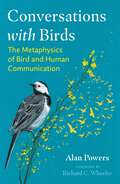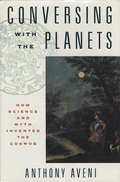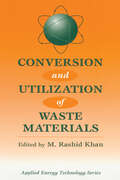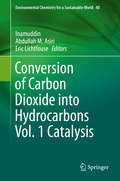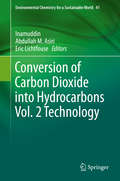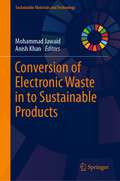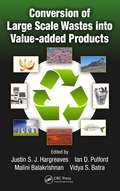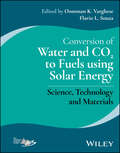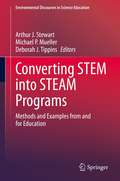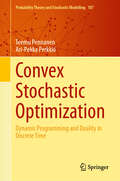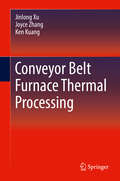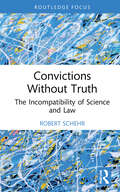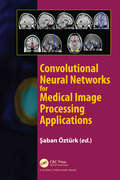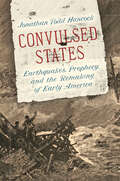- Table View
- List View
Conversaciones con María Teresa Ruiz
by Maria Teresa Ruiz Paula EscobarUn diálogo que repasa la trayectoria vital y profesional de la astrónoma y científica chilena más relevante de la última década Durante los últimos años, María Teresa Ruiz se ha convertido en una figura icónica de la astronomía. Ha sido «la primera» en múltiples ocasiones: desde la primera licenciada en astronomía y primera doctora en astrofísica de dos universidades, pasando por ser la primera mujer en obtener el premio nacional de ciencias hasta el premio de la UNESCO "Mujeres en la ciencia", que ha consolidado su reputación a nivel internacional. En estas conversaciones, Paula Escobar indaga en aspectos desconocidos e inéditos, hasta ahora, de la vida y obra de nuestra astrónoma más reconocida. Reseña: "Este diálogo constituye un paseo por el pasado, el presente y el futuro de la astronomía chilena."
Conversation Pieces
by Mark CarnallThis book, beautifully illustrated with specially commissioned photography, is a celebration of UCL's unique collections, with leading academics from the university invited to select and write about an object each found inspiring. From a jar of moles to an Egyptian unguent spoon, a finger X-ray to some prehistoric cereal grains, their choices were often surprising, their responses always fascinating.
Conversational Dialogue Systems for the Next Decade (Lecture Notes in Electrical Engineering #704)
by Zoraida Callejas Satoshi Nakamura Luis Fernando D’HaroThis book compiles and presents a synopsis on current global research efforts to push forward the state of the art in dialogue technologies, including advances to the classical problems of dialogue management, language generation, question answering, human–robot interaction, chatbots design and evaluation, as well as topics related to the human nature of the conversational phenomena such as humour, social context, specific applications for e-health, understanding, and awareness
Conversations on the Dark Secrets of Physics
by Edward Teller Wendy Teller Wilson TalleyIn Conversations on the Dark Secrets of Physics, Teller returns to the fundamentals of physics to share with readers his unbridled enthusiasm for the world of physical reality--from the nature of molecules to quantum mechanics and superconductors, from the elementary laws of thermodynamics to how planets, asteroids, and comets develop their orbits. By simplifying the math and forgoing the often-confusing technical jargon, Teller helps the reader break through physic's bewildering formulas and equations and get to the wonders of our physical universe. A timeless and personal explanation of the importance of physics in our life, Conversations on the Dark Secrets of Physics is certain to become a classic.
Conversations on the Edge of the Apocalypse: Contemplating the Future with Noam Chomsky, George Carlin, Deepak Chopra, Rupert Sheldrake, and Others
by David Jay BrownIn his latest interview collection, David Jay Brown has once again gathered some of the most interesting minds of today to consider the future of the human race, the mystery of consciousness, the evolution of technology, psychic phenomena, and more. The book includes conversations with celebrated visionaries and inspirational figures such as Ram Dass, Noam Chomsky, Deepak Chopra, and George Carlin. Part scientific exploration, part philosophical speculation, and part intellectual rollercoaster, the free-form discussions are original and captivating, and offer surprising revelations. Conversations on the Edge of the Apocalypse is a new look into the minds of some of our groundbreaking leaders and is the perfect gift for science fiction and philosophy fans alike.
Conversations on the Plurality of Worlds
by Bernard Le Bovier De Fontenelle H. A. Hargreaves Nina R. GelbartSurveying the night sky, a charming philosopher and his hostess, the Marquise, are considering the possibility of travelers from the moon. "What if they were skillful enough to navigate on the outer surface of our air, and from there, through their curiosity to see us, they angled for us like fish? Would that please you?" asks the philosopher. "Why not?" the Marquise replies. "As for me, I'd put myself into their nets of my own volition just to have the pleasure of seeing those who caught me. " In this imaginary conversation of three hundred years ago, readers can share the excitement of a new, extremely daring view of the universe. Conversations on the Plurality of Worlds (Entretiens sur la pluraliteacute; des mondes), first published in 1686, is one of the best loved classics of the early French enlightenment. Through a series of informal dialogues that take place on successive evenings in the marquise's moonlit gardens, Fontenelle describes the new cosmology of the Copernican world view with matchless clarity, imagination, and wit. Moreover, he boldly makes his interlocutor a woman, inviting female participation in the almost exclusively male province of scientific discourse. The popular Fontenelle lived through an entire century, from 1657 to 1757, and wrote prolifically. H. A. Hargreaves's fresh, appealing translation brings the author's masterpiece to new generations of readers, while the introduction by Nina Rattner Gelbart clearly demonstrates the importance of the Conversations for the history of science, of women, of literature, and of French civilization, and for the popularization of culture.
Conversations on the Uses of Science and Technology
by Norman Hackerman Kenneth Ashworth"In the interest of reducing financial support some policy makers in Washington and in state capitols are questioning the contributions of science to society. Or they believe research can be made more useful if it is controlled and directed by government to solve specific problems.<P> The authors disagree with both these strategies and discuss how understanding nature (that is, science) is the underpinning of humankind's progress in improved comforts, economic progress, and health. In making their case they also address the primary requirement of ensuring a pool of competent scientists, mathematicians, and engineers as well as the need for educating non-scientists about science."<P> --BOOK JACKET. Title, Summary field provided by Blackwell North America, Inc. All Rights Reserved
Conversations with Birds: The Metaphysics of Bird and Human Communication
by Alan PowersAn exploration of communicating with birds and the lessons they can teach us• Discusses specific birdtalk techniques and offers insights into many species• Looks at the long-standing tradition of &“avitherapy&” throughout history and in literature and the arts• Explains how song-talk with birds restores peace, calms anxiety, and enhances healthFor decades Alan Powers has studied bird vocalizations, developing the remarkable ability to imitate birds&’ songs and get them to respond and even change tunes. Through his years of study, he has discovered that birds can teach us important lessons about the world and about ourselves. As Powers explains, by communing cross-species we reach out to the timeless interconnected web of all life past and present--what Renaissance philosopher Giordano Bruno called in Latin the Uni-versus, the &“Whole turned into One.&” Sharing his journey to learn birdtalk and his profound observations about the poetic, spiritual, and healing influences of birdsong, Powers explores the ancient language of birds and the depth of meaning birds convey. He explains how bird speech sounds like song to us, but birdtalk is urgent and nuanced, whether about predators or the weather. He details how he began learning birdtalk, listening to one bird each summer, learning their many vocalizations and variations. Discussing specific techniques, he shares insights into the birdtalk of many species, including the complex and intelligent speech of Crows, the emotional depths of Loons, the mimicry of Blue Jays, and the beautiful song of the Wood Thrush. Exploring the intertwined metaphysics of bird and human languages, Powers looks at the long-standing tradition of &“avitherapy&” throughout history, literature, and the arts. He shares insights into birds from Shakespeare and Emily Dickinson, reveals how birds appear in love songs throughout the world, and examines how famous writers such as Keats, Catullus, St. Francis of Assisi, and the French historian Jules Michelet found that talking to birds improved their state of mind. He also explores how song-talk with birds restores peace, calms anxiety, and enhances health.
Conversing with the Planets: How Science and Myth Invented the Cosmos
by Anthony AveniConversing with the Planets is the first popular work of astronomical anthropology, a field pioneered by Anthony Aveni, who has taught anthropology and astronomy at Colgate University for over twenty-five years. It interweaves the astronomy, mythology, and anthropology of ancient cultures by showing how to discover the harmony between their beliefs and their study of the sky. Modern scientists often dismiss the scientific contributions of archaic astronomers because earlier cultures wove their observations into elaborate, often weird - by our standards - mythologies about living planetary deities. The ancients spoke to the planets, and they believed the planets talked back. Aveni urges us to reconsider their discoveries and asks us to set aside for a while the ideas that our modern, technology-based astronomy has given to us about the sun, moon, and planets, in order to look at these celestial bodies through ancient eyes. Focusing on the belief systems of the Mayans, Babylonians, Chinese, and other cultures from antiquity through the Renaissance to the present, Aveni argues that we cannot separate the scientific contributions from the cultures that gave rise to them. Aveni's reexamination, based on in-depth anthropological studies, including the decoding of old Mayan and Babylonian texts, reveals that the ancients were far from the misguided, superstitious characters we now consider them to be. They were, in fact, deeply attuned to the motion of the sun, moon, and planets, and they used their naked-eye observations to create not only intricate astrologies and mythologies - in particular, those revolving around Venus - but also extremely accurate records and projections of meteorologicalphenomena. Conversing with the Planets asks that we reattune ourselves to the intersection of science, culture, and mythology and acknowledge that there is no such thing as an "absolute truth" about the natural world; every scientific discovery, whether made in 2000 B. C. or A. D. , is true only for the culture of its time, its current beliefs and mores. Our scientific truth is defined by who we are and what we believe in. What have we moderns lost by turning our attention to the cold eye of the telescope, away from the natural harmonies of planet and sky? Why have we silenced the dialogue between observers and the sky? Aveni teaches us a new appreciation of the science of the past and affirms that our ancestors' discoveries provide a rich well of knowledge that modern-day science can and must draw upon.
Conversion And Utilization Of Waste Materials
by M.Rashid KhanThis text identifies the problems and opportunities of converting wastes into useful materials or fuels. Chapters cover such issues as waste Utilization And Recycling; Plastics, Polymers, Tyres And Automotive wastes; and the potential usage of coal conversion by-products.
Conversion of Carbon Dioxide into Hydrocarbons Vol. 1 Catalysis (Environmental Chemistry for a Sustainable World #40)
by Eric Lichtfouse Inamuddin Abdullah M. AsiriThis book presents the catalytic conversion of carbon dioxide into various hydrocarbons and other products using photochemical, electrochemical and thermo-chemical processes. Products include formate, formic acid, alcohols, lower and higher hydrocarbons, gases such as hydrogen, carbon monoxide and syngas.
Conversion of Carbon Dioxide into Hydrocarbons Vol. 2 Technology (Environmental Chemistry for a Sustainable World #41)
by Eric Lichtfouse Inamuddin Abdullah M. AsiriThis book presents chemical and biological methods to convert carbon dioxide into various products such as methanol, ethanol, formic acid, formaldehyde, volatile organic compounds, syngas and polymers.
Conversion of Coal-Fired Power Plants to Cogeneration and Combined-Cycle: Thermal and Economic Effectiveness
by Zbigniew Buryn Ryszard BartnikConversion of Coal-Fired Power Plant to Cogeneration and Combined-Cycle presents the methodology, calculation procedures and tools used to support enterprise planning for adapting power stations to cogeneration and combined-cycle forms. The authors analyze the optimum selection of the structure of heat exchangers in a 370 MW power block, the structure of heat recovery steam generators and gas turbines. Conversion of Coal-Fired Power Plant to Cogeneration and Combined-Cycle also addresses the problems of converting existing power plants to dual-fuel gas-steam combined-cycle technologies coupled with parallel systems. Conversion of Coal-Fired Power Plant to Cogeneration and Combined-Cycle is an informative monograph written for researchers, postgraduate students and policy makers in power engineering.
Conversion of Electronic Waste in to Sustainable Products (Sustainable Materials and Technology)
by Mohammad Jawaid Anish KhanThis book gives an overview of electronic waste (e-waste) management and the latest technological aspects of recycling and disposal of obsolete electronic components while minimizing the environmental impact of toxic chemicals and heavy metals from e-waste. As electronics become more accessible worldwide, this effect generates up to 50 tonnes of e-waste that is only set to increase every year. The chapters in this book explore different strategies through recycling practices, green computing, and eco-friendly approach in handling e-waste through government policies to mitigate the growing side effects of e-waste. This book caters to researchers, policymakers, and industrial practitioners who are interested in more sustainable practices in e-waste management.
Conversion of Large Scale Wastes into Value-added Products
by Malini Balakrishnan Justin S. J. Hargreaves Vidya S. Batra Ian D. PulfordThis book describes how large-scale wastes can be used as a resource for making other materials. It covers metal processing wastes (slag, red mud), fly ash from coal combustion, electronic waste, and food waste. These wastes have potential to be used in bulk (e.g., for construction applications) as well as for niche applications (e.g., in the areas of catalysis). This book reviews literature from around the world on how large-scale wastes are in use by industry as well as research on the potential applications of wastes.
Conversion of Lignin into Bio-Based Chemicals and Materials (Green Chemistry and Sustainable Technology)
by Chunbao Xu Fatemeh FerdosianThis book presents an overview of various types of lignin and their unique structures and properties, as well as utilizations of crude or modified technical lignin for high-value bioproducts such as lignin-based PF resins/adhesives, epoxy resins, PF foams, PU foams, rubber reinforcement and carbon fibers and as dispersants in drilling fluids in the oil and gas industry. It subsequently discusses various thermal/chemical modification techniques (pyrolysis, direct liquefaction and de-polymerization) for converting lignin into oils and chemical feedstocks, and the utilization of crude lignin, lignin-derived oils or depolymerized lignins (DLs) of reduced molecular weights and improved reactivity to produce lignin-based PF resins/adhesives, PF/PU foams and epoxy resins. The book will interest and benefit a broad readership (graduate students, academic researchers, industrial researchers and practitioners) in various fields of science and technology (chemical engineering, biotechnology, chemistry, material science, forestry, etc. ). Chunbao (Charles) Xu, PhD, is currently a Professor of Chemical Engineering and NSERC/FPInnovations Industrial Research Chair in Forest Biorefinery at the University of Western Ontario, Canada. Fatemeh Ferdosian, PhD, is currently a postdoctoral fellow at the University of Waterloo, Canada.
Conversion of Water and CO2 to Fuels using Solar Energy: Science, Technology and Materials
by Oomman K. Varghese Flavio L. SouzaConversion of Water and CO2 to Fuels usingSolar Energy Comprehensive Resource for Understanding the Emerging Solar Technologies for Hydrogen Generation via Water Splitting and Carbon-based Fuel Production via CO2 Recycling Fossil fuel burning is the primary source of carbon in the atmosphere. The realization that such burning can harm the life on our planet, has led to a surge in research activities that focus on the development of alternative strategies for energy conversion. Fuel generation using solar energy is one of the most promising approaches that has received widespread attention. The fuels produced using sunlight are commonly referred to as “solar fuels.” This book provides researchers interested in solar fuel generation a comprehensive understanding of the emerging solar technologies for hydrogen generation via water splitting and carbon-based fuel production via CO2 recycling. The book presents the fundamental science, technologies, techno-economic analysis, and most importantly, the materials that are being explored to establish artificial methods of fuel production using solar energy. For the rapid advancement of the field, it is necessary for researchers, particularly for those who are new to the field, to have clear knowledge of various materials studied so far and their performance. For this reason, almost half of the book is dedicated to the discussions on materials and properties. Key topics discussed in the book include: Photocatalytic/photoelectrochemical processes that use semiconductor photocatalysts, including both ceramic and non-ceramic materialsPhotovoltaic assisted electrochemical processesSolar thermochemical processesMolecular photosynthesis Researchers and professionals in the fields of energy and materials and closely related science and engineering disciplines could use this book to aquire clear insights on both mainstream solar fuel technologies and those in the developmental stages.
Converting Power into Chemicals and Fuels: Power-to-X Technology for a Sustainable Future
by Martin BajusCONVERTING POWER INTO CHEMICALS AND FUELS Understand the pivotal role that the petrochemical industry will play in the energy transition by integrating renewable or low-carbon alternatives Power into Chemicals and Fuels stresses the versatility of hydrogen as an enabler of the renewable energy system, an energy vector that can be transported and stored, and a fuel for the transportation sector, heating of buildings and providing heat and feedstock to industry. It can reduce both carbon and local emissions, increase energy security and strengthen the economy, as well as support the deployment of renewable power generation such as wind, solar, nuclear and hydro. With a focus on power-to-X technologies, this book discusses the production of basic petrochemicals in such a way as to minimize the carbon footprint and develop procedures that save energy or use energy from renewable sources. Various different power-to-X system configurations are introduced with discussions on their performance, environmental impact, and cost. Technologies for sustainable hydrogen production are covered, focusing on water electrolysis using renewable energy as well as consideration of the remaining challenges for large scale production and integration with other technologies. Power into Chemicals and Fuels readers will also find: Discussion of recent advances in power-into-x technologies for the production of ethylene, propylene, formic acid, and more Coverage of every stage in the power-into-x process, from power generation to upgrading the final product Thermodynamic, technoeconomic, and life cycle assessment analyses of each major process Power into Chemicals and Fuels is a valuable resource for scientists and engineers working in the petrochemicals and hydrocarbons industries, as well as for all industry professionals in these and related fields.
Converting STEM into STEAM Programs: Methods and Examples from and for Education (Environmental Discourses in Science Education #5)
by Michael P. Mueller Deborah J. Tippins Arthur J. StewartThis book examines the push and pull of factors contributing to and constraining conversion of STEM (science, technology, engineering and math) education programs into STEAM (science, technology, engineering, math and arts) education programs. The chapters in this book offer thought-provoking examples, theory, and suggestions about the advantages, methods and challenges involved in making STEM to STEAM conversions, at levels ranging from K12 through graduate university programs. A large driving force for STEM-to-STEAM conversions is the emerging awareness that the scientific workforce finds itself less than ideally prepared when engaging with so-called ‘wicked problems’ – the complex suite of emerging, multifaceted issues such as global climate change, social injustice, and pandemic diseases. Dealing with these issues requires cross-disciplinary expertise and the ability to insert technical and scientific understanding effectively into areas of public planning and policy. The different models and possibilities for STEAM, as the next phase of the STEM revolution, laid out in this book will promote research and further our understanding of STEAM as a forward-thinking approach to education.Gillian Roehrig, STEM Education, University of Minnesota, USAThe ideal teacher sees opportunities for integrating ideas from multiple disciplines into every lesson. This book offers many worthwhile suggestions on how to do that deliberately and systematicallyGeorge DeBoer, Project 2061 of the American Association for the Advancement of Science, USAFor the last several years, calls for expanding STEM education have grown, but so too have concerns about technocratic approaches to STEM. This volume challenges the community to consider broader views on STEM by focusing on the place of arts education within this movement. The chapters offer much needed, new perspectives on the (re)integration of the arts and sciencesTroy Sadler, School of Education, University of North Carolina, USA
Convex Stochastic Optimization: Dynamic Programming and Duality in Discrete Time (Probability Theory and Stochastic Modelling #107)
by Teemu Pennanen Ari-Pekka PerkkiöThis book studies a general class of convex stochastic optimization (CSO) problems that unifies many common problem formulations from operations research, financial mathematics and stochastic optimal control. We extend the theory of dynamic programming and convex duality to allow for a unified and simplified treatment of various special problem classes found in the literature. The extensions allow also for significant generalizations to existing problem formulations. Both dynamic programming and duality have played crucial roles in the development of various optimality conditions and numerical techniques for the solution of convex stochastic optimization problems.
Conveyor Belt Furnace Thermal Processing
by Ken Kuang Jinlong Xu Joyce ZhangThis practical book is tailored for engineers working in the industry, and condenses more than a decade's worth of application experience on furnaces. The various topics discussed include conveyor furnaces, belt furnaces, solar cells, brazing furnaces, thick film furnaces, and furnace air flow and reflow. There are chapters on the influence of belt furnace and firing on silicon solar cells, thin film CIGS solar cells, dye-sensitized solar cells, crystalline solar cells, and lithium ion batteries, as well as how the processes affect the efficiency of each. The authors also address the influence of belt furnace on various processes such as metallization, engine valve heat treatment, brazing, post mold curing, and glass-to-metal sealing. The last few chapters also address Direct Bond Copper (DBC) technologies, and the effect of profile and atmosphere on the reflow process.
Convictions Without Truth: The Incompatibility of Science and Law (Routledge Frontiers of Criminal Justice)
by Robert SchehrConvictions Without Truth sets out to determine whether and to what extent science and law may coexist in an institutional relationship that truthfully generates individualization through application of forensic testimony for charges relating to violations of criminal law. In the first two chapters, readers are exposed to contemporary unscientific forensic practices as juxtaposed to the evidentiary standard announced by the United States Supreme Court in Daubert v. Merrill Dow Pharmaceuticals, as well as scientific requirements for validity and reliability of expert witness testimony. The remaining chapters provide an explanation for retention of existing, though faulty, forensic practices by way of analysis of path dependency, the fixation of belief, and neuro and cognitive psychology. Through immanent critique and unmasking, the book deconstructs prevailing forensic practices through application of existing published documentation. The final chapter addresses the fixation of belief from the perspective of neuropsychology and cognitive psychology. Readers will gain an understanding of the current concerns relating to application of contemporary forensic practices ; current case law and federal rules guiding the introduction of expert witness testimony; and why it is that despite widely recognized concerns raised from within and outside of the criminal legal system, application of unscientific forensic practices continues., The book also shows how the criminal legal system is experiencing a paradigm shift due to dialectical juxtaposition of existing unscientific forensic practices with contemporary science. Readers are shown that because of its continued reliance upon unscientific forensic practices, the criminal legal system reveals its hegemonic commitment to social control through its willingness to accept "satisfying" as opposed to "truthful" results that generate wrongful convictions. Convictions Without Truth will be of particular interest to students, academics, and practitioners working within the criminal legal field. It will also appeal to those wanting to know more about forensics and criminal law.
Convolutional Neural Networks for Medical Image Processing Applications
by Şaban ÖztürkThe rise in living standards increases the expectation of people in almost every field. At the forefront is health. Over the past few centuries, there have been major developments in healthcare. Medical device technology and developments in artificial intelligence (AI) are among the most important ones. The improving technology and our ability to harness the technology effectively by means such as AI have led to unprecedented advances, resulting in early diagnosis of diseases. AI algorithms enable the fast and early evaluation of images from medical devices to maximize the benefits. While developments in the field of AI were quickly adapted to the field of health, in some cases this contributed to the formation of innovative artificial intelligence algorithms. Today, the most effective artificial intelligence method is accepted as deep learning. Convolutional neural network (CNN) architectures are deep learning algorithms used for image processing. This book contains applications of CNN methods. The content is quite extensive, including the application of different CNN methods to various medical image processing problems. Readers will be able to analyze the effects of CNN methods presented in the book in medical applications.
Convulsed States: Earthquakes, Prophecy, and the Remaking of Early America
by Jonathan Todd HancockThe New Madrid earthquakes of 1811–12 were the strongest temblors in the North American interior in at least the past five centuries. From the Great Plains to the Atlantic Coast and from the Great Lakes to the Gulf of Mexico, a broad cast of thinkers struggled to explain these seemingly unprecedented natural phenomena. They summoned a range of traditions of inquiry into the natural world and drew connections among signs of environmental, spiritual, and political disorder on the cusp of the War of 1812. Drawn from extensive archival research, Convulsed States probes their interpretations to offer insights into revivalism, nation remaking, and the relationship between religious and political authority across Native nations and the United States in the early nineteenth century. With a compelling narrative and rigorous comparative analysis, Jonathan Todd Hancock uses the earthquakes to bridge historical fields and shed new light on this pivotal era of nation remaking. Through varied peoples' efforts to come to grips with the New Madrid earthquakes, Hancock reframes early nineteenth-century North America as a site where all of its inhabitants wrestled with fundamental human questions amid prophecies, political reinventions, and war.
Cooke and Wheatstone: And the Invention of the Electric Telegraph (Routledge Library Editions: History & Philosophy of Science)
by Geoffrey HubbardOriginally published in 1965. Charles Wheatstone collaborated with William Cooke in the invention and early exploitation of the Electric Telegraph. This was the first long distance, faster-than-a-horse messenger. This volume gives an account of the earlier work on which the English invention was founded, and the curious route by which it came to England. It discusses the way in which two such antagonistic men were driven into collaboration and sets out the history of the early telegraph lines, including work on the London and Birmingham Railway and the Great Western Railway.

